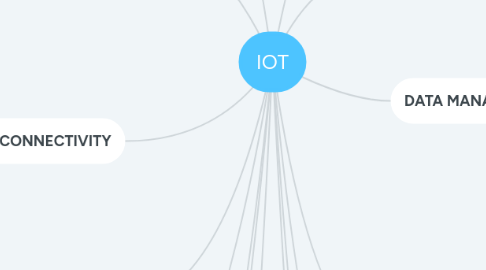IOT
by SCALVIN IMMANUEL URK17EE005

1. INDUSTRIAL IOT
1.1. IOT AND I-IOT- SIMILARITIES AND DIFFERENCES
1.2. INDUSTRIAL OEM PLATFORMS
1.3. INDUSTRIAL DATA FLOW AND DEVICES
2. CLOUD COMPUTING,EDGE COMPUTING AND IOT PLATFORMS
2.1. CLOUD ARCHITECTURE
2.1.1. IAAS
2.1.2. PAAS
2.1.3. SAAS
2.2. IOT CLOUD PLATFORMS
2.2.1. AZURE IOT HUB
2.2.2. AWS IOT CORE
2.2.3. CLOUD IOT CORE ON GCP(GOOGLE CLOUD PLATFORM)
2.3. EDGE COMPUTING PLATFORMS ON CLOUD
3. IOT CONNECTIVITY
3.1. IOT NETWORK PROTOCOL STACK
3.1.1. TEMPERATURE MONITORING USING ARDUINO
3.2. IOT COMMUNICATION
3.2.1. IOT SHORT RANGE COMMUNICATION
3.2.1.1. BLUETOOTH, ZIGBEE, 6LoWPAN, WI-FI
3.2.2. IOT LONG RANGE COMMUNICATION
3.2.2.1. CELLULAR - LTE-M,SIGFOX,ARCHITECTURE,LPWAN - LoRa
4. BUILD AN IOT END DEVICE
4.1. OBSTACLE COUNTER USING ARDUINO AND HC05
5. HIGHER OPERATOR PRODUCTIVITY
5.1. Industrial IoT can increase the productivity of the manufacturing workforce in several ways. Let’s start with the operators. Using IIoT enabled tools, operators can go through workflows faster without compromising quality. For example, pick-to-light devices can help operators find the piece they need much more quickly and thus reduce their cycle time.
6. IMPROVE QUALITY THROUGH CONTINUOUS MONITORING
6.1. Quality management systems (QMS) are hard to implement and maintain. Industrial IoT can help reduce the costs associated with them by automating and streamlining the process control plan. Using sensors, manufacturers can automatically check variables that are critical to quality, thus reducing the time and resources dedicated to the QMS. Rather than manually performing quality inspections, they can use IoT sensors to streamline the process.
7. INCREASE MACHINE UTILIZATION
7.1. Industrial IoT enables manufacturers to connect their machines to the internet. This capability lets manufacturers not only monitor their machines, but also measure important KPIs such as overall equipment effectiveness (OEE) and overall process effectiveness (OPE) in real-time. Tracking these metrics lets manufacturers identify and fix causes of unplanned downtime, provide preventive maintenance to their equipment, and thus increase machine utilization throughout the shop floor.
8. SUPPLY CHAIN OPTIMIZATION
8.1. IoT enabled sensors to permit monitoring of events across a supply chain, providing access to real-time information by tracking inputs, equipment, and products. RFID tags and other sensors can be used to track inventory as it moves around the supply chain. This provides manufacturers visibility into inventories and more realistic timelines for material availability, work in progress, and so on. Using this data, manufacturers can identify interdependencies, map material flow, and track manufacturing cycle times. This data helps manufacturers predict issues. It also reduces inventory and potentially reduces capital requirements.
9. AZURE IOT
9.1. IOT HUB ENDPOINTS
9.2. VISUALIZE REAL TIME WEATHER DATA COMING FROM DHT 11 SENSOR INTERFACED WITH RASPBERRY IN POWER BI
9.3. AZURE EDGE COMPUTING
10. AWS IOT CORE
10.1. SEND WEATHER DATA FROM RASPBERRY PI AND VIEW IN QUICK SIGHTS DASHBOARDS
11. DATA MANAGEMENT IN IOT
12. PRODUCTION VISIBLITY
12.1. Industrial IoT can connect machines, tools, and sensors on the shop floor to give process engineers and managers much-needed visibility into production. For example, manufacturers can automatically track parts as they move through assemblies using sensors such as RFID and break beams.
13. FASTER IMPROVEMENT CYCLES
13.1. Operators aren’t the only ones who benefit from IIoT. Process engineers (as well as manufacturing engineers, quality engineers, and in general all frontline engineers in the shop floor) benefit as well. Without IoT, shop floor engineers must manually collect, aggregate, and analyze data. An IoT enabled shop floor, on the other hand, gives them the ability to automate data collection so they have more time to spend improving processes.
14. IMPROVE QUALITY THROUGH CONTINUOUS MONITORING
14.1. Environmental sensors can continuously monitor conditions critical to quality and alert management when quality thresholds are crossed. For example, in a pharmaceutical operation, temperature can be critical to quality. By using IoT connected temperature and humidity sensors, managers can monitor those variables and be instantly alerted if they go outside the expected parameters.
15. BETTER FACILITY MANAGEMENT
15.1. Leveraging sensors in manufacturing facilities can improve their management and therefore reduce the operational costs of a factory. For example, using sensors such as RFID tags to monitor facilities, manufacturers can gain insights to help them optimize space usage. Another way in which IoT enabled sensors can help manufacturers better manage their facilities is by ensuring environmental variables such as temperature, humidity, or others, stay within the prescribed range.



